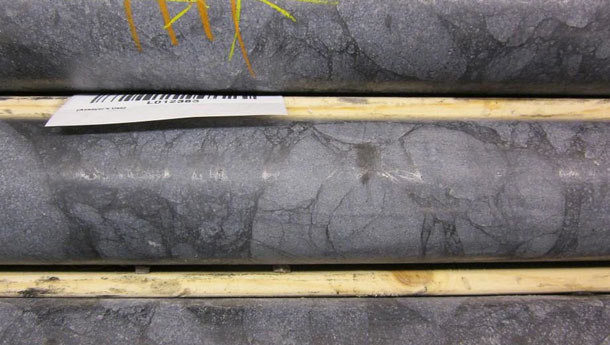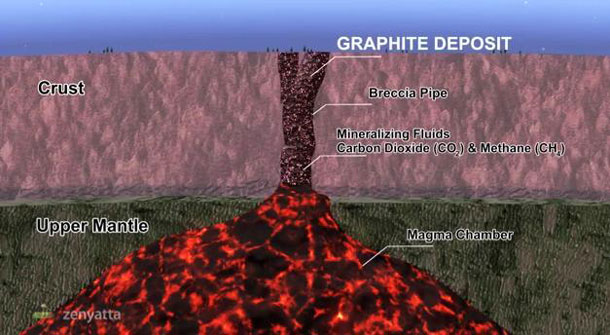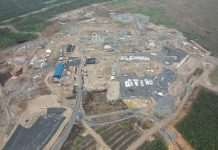
THUNDER BAY – MINING – Zenyatta Ventures Ltd. (“Zenyatta” or “Company”) (TSXV: ZEN) is pleased to report positive results from initial testing of several high purity Albany graphite samples for use in powder metallurgy (‘PM’) application.
Testing was conducted at the National Research Council (‘NRC’) in Ottawa, Canada and was partially funded by a federal research grant through the National Research Council of Canada Industrial Research Assistance Program (NRC-IRAP). Screening results for various properties support suitable use of this unique hydrothermal graphite in the targeted PM application.
Zenyatta graphite samples were mixed with steel, copper and lubricant powders to produce a powder metallurgy specimen. The flow properties of the mixture compare favorably with the mixture made with benchmark materials in existing use. In addition, the mechanical properties of the final Zenyatta artifacts, after a sintering heat treatment, were comparable to those of the benchmark artifacts.
Highlights:
- Zenyatta’s graphite shows the very important high purity and particle size specifications required for PM application; Primary testing has shown our graphite to perform well in PM applications when compared to reference graphite material;
- The largest market for metal powders is in the production of automotive PM parts. Other uses for PM include specialized parts for military, aerospace, energy, medical, electronics, computers and household appliances;
- Zenyatta expects to have a targeted market application segmentation which includes 25-30% for high purity graphite in PM, 25-30% in Lithium-ion batteries and 20-25% for Fuel Cell products. The remaining 15-30% target applications will be discussed in upcoming news releases.
Dr. Bharat Chahar, VP of Market Development for Zenyatta stated, “These latest screening tests conducted at NRC continue to show positive attributes of Zenyatta graphite in multiple applications. It provides further evidence of the suitability of this unique material in many cleantech applications that we are targeting. The Company will continue test programs at other labs and with global end-users but will involve larger scale test equipment to provide more extensive data to progress our market development plans.”
During the same NRC program, samples of Zenyatta’s high purity graphite were tested for various properties relevant for use in fuel cell components and in Li-ion battery applications. Testing was carried out on a simulated fuel cell component called a bipolar plate made with the Zenyatta graphite. When tested, the plate had resistivity properties comparable to a bipolar plate made using existing benchmark synthetic graphite material in use today. This test further supports results announced by Zenyatta on 9 March 2015 ‘Initial Screening Shows Albany Graphite Material to be Suitable for Hydrogen
Fuel Cell Components; Company Collaborates with Global Leader in Fuel Cell Technology Supported by the Government of Canada’.
Li-ion battery (coin cells) tests conducted by NRC also supported previous good performance results by other labs and end-users of Albany graphite in this application. Zenyatta announced on 12 February 2015 ‘Initial Testing of Albany Graphite Yields Positive Results for Lithium Ion Battery Anode Application’.
Dr. Chahar added, “Since the purity and particle size of the Zenyatta material provided was already in the range needed for PM application, no further milling or purification was needed. Due to simple mineralogy, high crystallinity and desirable particle size distribution, the Albany graphite has shown first testing specification ranges needed for the PM industry. While further tests will be conducted to verify other performance characteristics, this initial feedback on results is extremely encouraging.”
Zenyatta commenced a market development program several months ago under the guidance of Bharat Chahar to initiate validation of Albany graphite in high purity graphite applications. Since the start of this program, the Company has had detailed conversations with more than 35 graphite end-users, academic labs and third party testing facilities in Europe, North America and Asia under confidentiality agreements. Many of these organizations requested a specified amount of purified Albany graphite produced at SGS Canada Inc. (‘SGS’) Lakefield site during the development of a process flow sheet for the Albany graphite deposit. The samples produced at SGS are experimental in nature and may differ slightly from batch to batch and may also differ from the final product in the future. However these samples are representative of the product that could be processed and provide a good initial assessment and guidance for the potential of Albany graphite for various applications.
The goal of these initial samples was to screen Albany graphite for suitable applications while gathering feedback from the end-users and testing facilities to improve the overall properties for high value applications. The Company is now starting to receive feedback from several end-users and independent labs, some of which received repeat samples. Information from this initial test program will be used to further define the Company’s product and market strategy, and to set the stage for the next steps in development. Zenyatta plans to provide its stakeholders brief periodic updates on the progress as meaningful information becomes available.
PM is a fabrication technique that uses metal powder to manufacture complex industrial parts. It involves blending ultra-fine powdered materials, pressing them into a desired shape and then heating the compressed material to bond. The PM process generally consists of four basic steps: powder manufacture, powder blending, compacting, and sintering at high temperatures. Optional secondary processing often follows to obtain special properties or enhanced precision of those parts. The PM market is relatively large and shows high growth potential. Graphite for this market has to meet many challenging performance characteristics before it can be used.
Since the mid-1990s, synthetic graphite is mostly used due to its higher purity, consistency and particle size. High-purity graphite of greater than 99.5% Cg is preferred, with a particle size of around 5 microns. Presently, primary synthetic graphite is used and produced in a highly controlled graphitization process, which assures narrow specifications, consistent purity, perfect crystalline structure and well defined texture.
Graphite is used in powdered metals as a source of carbon for the sintering process where it acts as a strengthening agent and as a lubricant. Graphite aids the release of PM parts from the die and is also used in conjunction with non-ferrous soft metals to provide self-lubrication (i.e. steel, brass and copper parts). The addition of graphite to ferrous parts, soft metals and ultra-hard alloys ranges from 0.2 to 3.5% of the total metal weight. Graphite is used because it is an excellent electrical and thermal conductor, it has outstanding lubrication properties and it is resistant to oxidation and cyclic temperature stress. It can withstand extreme temperatures while maintaining strength and shape. It is also inexpensive, light weight, easy to machine and replace compared to other materials.
The PM market is estimated to be worth US$24 Billion (~1.5Mt) annually of which the graphite portion is estimated to be US$200 Million (~20,000t) annually and growing at ~5% CAGR. Production of metal powders is practiced throughout the major industrial regions of the world with the largest market (at 80%) in the production of automotive PM parts. Based on forecast automotive demand, production of metal powders is expected to grow by 5% per year with the highest growth rate expected to be in Asia, where metal powder output is forecast to grow 9% per year. The demand for specified graphite in this market is expected to grow at the same rate as the overall PM market growth rate of 5% per year. Other uses for PM include specialized parts for military, aerospace, energy, medical, electronics, computers and household appliance applications.







